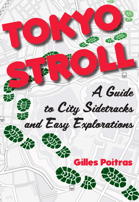
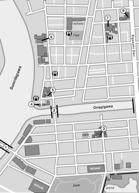

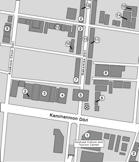

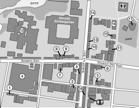






Tokyo Stroll Supplement: Navigating Tokyo, the basics of getting around the city
To the visitor getting around Tokyo may be intimidating. The mass transit system is huge, the signs are mainly in a language most visitors cannot read or speak, and Tokyo has 14.5 million in population and millions more come in to work and shop each day. The reality is it is not that hard to navigate the city, if you know how.
While this page is written with Tokyo in mind much of this guide applies to any Japanese city.
- COMFORT IN WALKING -
| Shoes: | ||
| - You will need good shoes. It is also advisable to have shoes that come off and on easily. You may have need to remove them in some businesses. Such places often have a shoehorn near the entrance, usually one long enough to be used standing up. - Some guidebooks recommend bringing two pair of shoes to alternate and give your feet a rest. I recommend you bring a different set of insoles and take up less space in your luggage. - If you wear sneakers you may want to pack a second pair in case the first wear out. - To protect against sore spots on your feet I recommend buying a packet of Mole Skin and packing a pair of small scissors into your checked luggage or buying some at a convenience store in Tokyo. - Tokyo is a pedestrian city, relatively few people own cars and those that do don't use them much. City planning takes this into consideration so there is an excellent mass transit system, much of it privately owned. Also be aware that most streets are narrow and have no sidewalks, you walk on the street moving aside when cars need to get by. - Tokyo also is built on several elevations from low lands year Tokyo Bay to the hills starting not very far inland. The hills mean there are plenty of stairs, add to this the extensive train and subway system and you have more stairs. However as a result of the preparations for the 2020 Olympics most stations now have elevators and escalators. |
||
| Sidewalk etiquette, a few tips: | ||
| - On crowded sidewalks walk on the left. North Americans normally walk on the right so you may need to remind yourself time and again to shift to the other side. - If you need to talk on your phone on the sidewalk move to the curb and do so standing. It is considered rude to have a conversation while walking as you cannot be as aware of other people around you. - Also don't eat and walk for the same reason, plus there are few trash receptacles on the streets. - Most parts of Tokyo ban smoking on busy sidewalks with the exception of designated places to stand and smoke. - If you hear the bell or squeaking brakes of a bicycle behind you move to the side and let them pass. - If you are using GPS navigation in a smartphone while walking do not look down. Instead look straight ahead, raise the phone to eye level and take your bearings before moving the phone back down and continuing on. |
||
- GETTING THERE AND FINDING YOURSELF -
| An Atlas: | ||
| - See my Tokyo Stroll Supplement: Viewing Locations in Organic Maps, Maps.Me, Google Maps, or Google Earth page for detailed information on using bookmarks I have created to locations that are in Tokyo Stroll and the web supplement. - Strange as it may seem I actually recommend you consider buying a copy of the Japanese / English Bilingual Atlas of TOKYO Covering All 23 Wards for your trip. In fact buy this atlas if you can before your trip so you can get familiar with the layout of the city and how the atlas works. The atlas is now out of print but used copies show up on occasion on Amazon Japan. The atlas only covers the high density 23 ku (ward) portion of Tokyo, the most difficult part to navigate, in very good detail. Other atlases and maps leave out smaller streets greatly reducing their usefulness. TIPS: - Keep the atlas with you at all times. - Rail maps with station names in Roman letters and kanji can also be useful. - Much of what I write below assumes you have this atlas. |
||
| A compass: | ||
| - Bringing a compass may seem silly especially if you are confident of your map reading skills. However almost all of the older parts of Tokyo preserve the original street structure rather than having a neat grid layout. In many areas the old street design was intentionally confusing to slow down and misdirect invading armies, or it was laid out according to the plots of farmland that were there before the area was developed. It is very easy to end up going at a tangent from the direction you wanted to go in if you do not know the neighborhood itself. Of course if you are simply ambling about taking pictures this could be fine, unless you have specific places you want to get to that day. Imagine how useful a compass could be at night when you cannot gauge direction by the sun. | ||
| Finding an address: | ||
| - If you like solving puzzles Tokyo addresses can be fun. Otherwise they can be difficult, annoying or impossible depending on your level of skill. Almost all streets do not have names and buildings do not have numbers. In fact businesses usually include maps in their ads to help people find them. | ||
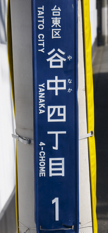 |
The Japanese address system works, from general to specific, like this:
It is written in the reverse order of the above. For example Tokyo Tower is at:
|
|
| TIPS: - You can also do what many people do, Japanese included, ask a policeman at the local koban. Part of the duties of the police at the koban is to give directions. - Most areas will have vertically oriented location signs mounted or painted on utility poles or walls to tell you where you are. - In some places you may see large maps at the edge of the sidewalk. On those maps the top is not North but the direction you are facing. |
- MEANS OF TRANSPORTATION -
| Trains and subways: | ||
| - Tokyo has a very large system over 600 hundred train and subway stations positioned in such a way that transfers are easy. Don't let the size of the system intimidate you. If you are familiar with an urban mass transit system, either rail or bus lines, the Tokyo system is simply a larger version of what you have already used. | ||
| Finding your line: | ||
| - The easiest way to get from point A to point B is to find the line that runs closest to your destination. Then find the lines that are close to where you are. If they are on the same line it is easy, if you have to transfer simply find a common station in the system. Transferring is easier in the 23 ku area than further out due to a higher number of intersecting lines. Make sure you get on the platform in the direction you are going, the maps in the station can be helpful. | ||
| Rail and subway maps | ||
| Aside from the maps in the atlas, Google Maps, and there are maps provided by the rail and subway companies. For the subway system Tokyo Metro puts out an excellent downloadable map in several languages with explanations of station symbols, Tokyo Metro Subway Map. The major rail company in the Tokyo area is JR-East and they have several maps and guides you can download, including one for the Tokyo area that includes other companies, Maps & Guides JR-East | ||
| Finding the cost of your ticket: | ||
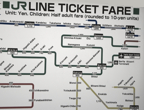 |
- Each station will have in Roman letters at least one table of prices or fare map near the ticket machines or map up high above the ticket machines with the prices for tickets to stations on the lines services by that station. Or just get the transit card mentioned below and keep cash on it. Sometimes the maps will include other lines from the same company but not from other companies. In some older stations that have separate entrances for each platform the sign location may be only on one side and not the other. - Some stations will have more than one line and in some cases the fare maps will only be for a single line, the other maps should be nearby. - Some stations have a transfer discount machine to use inside the system if you are going from one company's system to another. The Tokyo Transfer Guide website is the easiest way to calculate the costs of an intersystem trip in Tokyo. TIP: - If you are pressed for time buy a ticket for the next station, go to your destination and use the "fare adjustment" machines near the exit to add the amount to your ticket that you need to leave the paid area. |
|
| Using a smart card as a pass: | ||
 |
- Using a prepaid smart card is much easier than having to figure out how much value you need on a ticket each time you want to use a train or bus. Tokyo has two smart cards you can use to pay for mass transit. These are the Suica and PASMO cards. In Tokyo all transit systems accept both cards. - However I especially recommend the Suica card as it can be used on more systems in the broader Kantō area as well as an increasing number of other areas in Japan. You can buy the Suica card from a special ticket machine at larger JR stations. You can add value to the Suica and PASMO cards at either JR and Tokyo Metro ticket machines. There is a special PASMO card for international travelers called the PASMO Passport. NOTE: - You cannot add value to the cards using the ticket machines of companies other than JR. Tokyo Metro or the Tokyu Toyoko Line stations, instead you may find yourself accidentally buying a ticket you did not want. - As you use your card to enter or exit stations the value used and the value left on the card are quickly displayed on a small screen at the gate. Any transfer discount is automatically applied. Be sure to keep extra cash on the card, I usually try to keep at least 1500 yen on my card. If your card does not have enough money on it for you to exit there will be a machine near the exit gates where you can add value to the card. Just drop 1000 to 2000 yen on it and you will be fine for some time. If you leave Japan with money on your card just keep it, the card will not expire for 10 years and you surely want to return don't you? I recommend keeping some money on it so when you do return you can easily start using it right away. - You can also use both cards at many vending machines, convenience stores, coffee shops etc. On one trip I used the last of my card at the airport buying coffee and a pastry. |
|
| Day Passes: | ||
| Day Passes are not all that useful for two reasons. - One, they are not that inexpensive. - Two they are for only one company and given the number of different transit companies in Tokyo they are often not practical for tourists who may need to transfer between systems. |
||
| Locating train stations: | ||
  |
- Train stations are relatively easy to locate as they are above ground. For subway stations you will have to look for signage to the station. On the street look for the distinctive logos used by subway lines. You will also see directional signage in underground walkways between stations, underground shopping arcades and some large store basements. NOTE: - Train and subways lines are color coded. In most systems this extends to the color of the cars, the stations are also numbered in sequence. On some lines individual stations will have their own platform tune.  |
|
| Exiting stations: | ||
| - Leaving a station can be as easy as heading to the nearest exit and figuring out how to get to where you want to be from there. But that is not always the best, most stations have multiple exits, some connect to tunnels that take you a great distance underground which is handy in some circumstances to avoid waiting for lights, avoiding rain, etc. - However usually all you need to do is find the exit closest to your destination in as map in the station or the atlas. For example look at map 5 in the atlas, see the blue lines starting at the station following the streets? These are tunnels, so if you are looking to get to the Shinjuku ward office (at B-3) you would take exit 15b. Now most stations are not this complex but it is usually much easier to get to an exit on the same side of the street as the direction you want to go. TIPS: - If you are meeting someone at a station be sure to have a location chosen. A local landmark is best, or if at an exit choose which exit since even smaller stations can have several. - If you need to stop in the station to figure out which exit to take be sure to stand off to the side and do not block walkways.  |
||
| Exit elevators and escalators: | ||
| - In the subways get used to identifying the elevator and escalator signs at stations and use them. A full day of walking is made much easier if you reduce the stress on your body by not using stars unless you have to. Using elevators and escalators to go up at stations is handy if you are starting to run out of steam, have problems walking or just want to conserve energy to do as much as possible in one day. Not all train and subway stations in Tokyo have elevators. Most do but some of the older ones have not had them installed yet. On escalators you will see people standing to the left and leave room for people who are walking up them to pass. This is being discouraged as a safety measure you may still see people doing this, just follow their example. Some subway stations may be so far underground that you have to take a series of three or more escalators to get to the surface. | ||
| Priority seats: | ||
| - On trains be aware that there are some seats reserved for elders, pregnant women and the disabled. These are at the ends of the cars between the doors and inter-car passages. These are also marked by signage near them. | ||
| Women's only cars: | ||
| - On some train lines there are train cars reserved for women, these usually run during commute hours. Some companies may have them throughout the day or also have them late in the evening. The stops for such cars are clearly marked on the platforms, when in doubt, if you are male, only enter cars where men are getting on. Such cars are not unique to Japan many countries have them, in the 19th and early 20th centuries some European and American railroads also had them. | ||
| JR Pass: | ||
| - I recommend you skip getting a JR pass, Japan Rail Pass, unless you plan to do several long distance overnight trips well outside Tokyo. The passes are not cheap, are only useful for a limited amount of time, and are only good on JR lines. Also do you really want to spend large chunks of time traveling long distances? - However if you do plan to hit places some distance away such as Kyoto or Nara the pass can save you money. |
||
| Buses: | ||
| - Buses have a single fare within the 23-ku area, the fare can vary slightly between different companies. - Some buses are boarded from the front, others from the back and exited from the front. Just follow the example of locals getting on the bus or directions from the driver. - If entering from the back and using a smart card you may need to use the card entering and then again as you exit from the front. - Also be aware that bus routes are sometimes rambling as the train lines handle much of the direct line traffic, if you are sure as to where the bus is going it will get you there. |
||
| Taxis: | ||
| - The cabbies won't like my saying this but avoid them if you can as they are not cheap. The drivers usually don't know English and you often have to give directions or provide a map. If you do need to take a cab pick a landmark near where you are going to go to and have the driver drop you off there. By the way, don't open the door, they open with a switch operated by the driver. | ||
| Car rental: | ||
| - Renting a car is only useful for travel in rural areas and traveling between cities. It is too confusing to drive in Tokyo unless you know the city well and then parking is not always easy to find and often expensive. Plus you need to be at least 18 years old, and have a Japanese driver's license or an International Driving Permit (IDP) in order to rent and drive a car in Japan. Highway signs outside the major cities are often only in Japanese. | ||
| Water buses: | ||
| - One fun thing is taking a water bus. These run in major rivers, the Sumidagawa has several. Some have platforms on the roof so you can stand outside to enjoy the view and take pictures. Some very popular ones, with no outside platform, are Himiko, Hotaluna, and Emeraldus which run Mainly between the Asakusa area and Odaiba, they were designed by Matsumoto Leiji the science fiction manga artist who wrote the Galaxy Express and Captain Harlock sagas. A water bus can also be a quicker way to move between two locations near the river. - In Yokohama there is the "Sea Bass" water buses connecting the Yokohama Station East Exit, Minato Mirai Pukarisanbashi Pier and Yamashita Park. |
||
- MONEY -
| Cash: | ||
| - Expect to carry cash. Japan mainly operates on cash rather than checks or credit cards. Many businesses that take credit cards are usually either in areas frequented by tourists, such as Akihabara, or are expensive shops and restaurants. - Consider buying a coin purse, they have nice ones in Japan, as the smallest bill is the 1,000 yen note which means you quickly end up with a pile of coins. Put some bills, say 6,000 yen worth, in a separate part of your wallet as a reserve to keep from running out. Don't worry about having plenty of cash on you, Tokyo is one of the safest cities in the world. Do watch out for pickpockets in crowds, I had one try for my wallet at Otori Jinja in Senzoku (find it in the atlas) during the Ichi-no-Tori festival a few years ago, they failed. IMPORTANT TIP: - Be sure to notify your bank and credit card companies that you will be in Tokyo. Otherwise you may find your account blocked. NOTES: - Some shops will ask if you want the credit card payment split into more than one purchase. I recommend just saying one. - My personal preference for using cash is partly due to making sure the shop gets all the money rather than the credit card company taking a percentage. |
||
| Obtaining cash: | ||
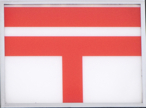 |
- My preference is to exchange my money at airport when I arrive in Japan. You get a better exchange rate and pay a far lower fee than you would at your home bank. Check with your bank to see what their fees are and you may be surprised how much they charge. Exchange enough to last several days and be aware you will need more the first day for a transit card, transportation from the airport etc. Once you have booked into your lodgings, some of which require prepayment in cash, you are ready to explore. - To obtain cash on the go there are two major places for tourists. The post offices, which have international ATM machines available during business hours and many convenience stores have international ATM machines. You can easily identify the post office with their distinctive red and white logo that looks like a capital T with a bar over it. Be aware that you will need to know your PIN as a number not as a word, Japanese ATM machines do not have letters on the keypads. In a pinch you can check the keypad of a cell phone to find the numbers as the design is the same. For me I use the post office as they charge a very low fee and my credit union also does not charge international transaction fees. A friend uses his credit card at the 7-11 machines as his US bank does charge fees for using his ATM card in Japan. NOTE: - There are two exchange counters at Narita Airport, and at Haneda, near the exit gates operated by different banks. The rates may be better at one than the other. |
|
| Credit Cards: | ||
| - It is worth having a credit card for some shops and as a backup in case your ATM card gets blocked by your bank (even if you told them you would be in Japan). A second credit card can be useful in case one is declined for some reason. | ||
- EATS AND AFTERWARDS -
| Food: | ||
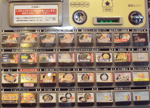 |
- OK you have your luggage stashed in your room, you have your comfortable shoes, your atlas and cash. Now you need fuel, that is food. - I have a Tokyo Stroll Supplement page that will cover most of your questions: Tokyo Stroll Supplement: Eating In Tokyo - Do you want to avoid places that allow smoking? Most non-smoking places post a sign at the door. Here is a template for printing cards to ask about non-smoking. Non-smoking request PDF |
|
| Toilets: | ||
 |
- After food eventually comes the expected. Accessible toilets are easier to find than in many cites. In the stations they tend to be within the paid areas, large shopping buildings have them on some floors, public parks have them and in a pinch just ask at a convenience store, the Japanese know the meaning of the English word toilet. TIP: - Some park toilets may be out of paper so carry a pack of tissue with you when you wander about. Paper towels or hand blow driers are also at times not available, many Japanese use their handkerchief to dry their hands, not to blow their nose, take one along when you go out. Warning: - You may run across a traditional squat toilet (aka scary toilet) on occasion, especially in older parks. If you are an experienced camper you will have no trouble using it, otherwise keep looking. |
|
- TIPS AND SUGGESTIONS -
| Tightfisted?: | ||
| - Check out my Tokyo on the Cheap: The Basics of Keeping Your Expenses Down web page for tips on saving money when going to Tokyo. | ||
| Tablet: | ||
| - If you have a tablet consider loading up your iBooks with PDF maps and informative information. Many of the official tourism sites for Tokyo and nearby areas have such files on them. If you have a Mac or use the Chrome browser on your Windows machine you can print web pages to PDF files and add those. I organize mine as collections by location on my iPad. | ||
| Picture context: | ||
| - I take lots of pictures and when I get home write up a document describing the locations by photo number. Rather than carry around a notebook and write down notes as I wander about I take photos of location specific items, subway exit signs, landmarks, locals maps etc. This is much easier than asking your friend "Where did I take this picture?" and getting a reply like "I don't know I think I was hung over that day." |
||
| Cell Phone: | ||
| - There is more than one way to deal with using a cell phone, You can go with an international plan from your phone company, buy a chip once you get there or you can rent a cell phone. All of this assumes you have people to call or who would be calling you. Otherwise turn off your phone when you get on the plane to head to Japan and turn it back on when you return from Tokyo. | ||
Thanks for providing corrections, suggestions etc. go to Michelle Le, Glenn Schmall, Kaki Hu Chung and James Welker.
Page Created July 15, 2013 | Updated August 23, 2023